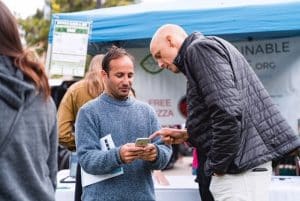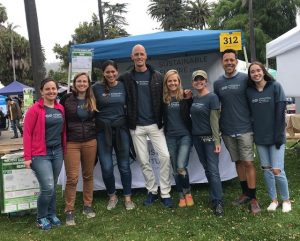BY SAM WATERSTONE | May 17, 2019
When the United States withdrew from the Paris Climate Agreement in 2016, environmentalists around the country were disappointed and frustrated. Nevertheless, green-thinking individuals like Santa Barbara’s Seth Streeter believed that the decision could serve as a catalyst for a new wave of collective sustainable action.

This influenced Streeter to organize his own environmental group focused on promoting sustainable practices and encouraging collaboration throughout the entire Santa Barbara community. Streeter is CEO of Mission Wealth, a Social Venture Partner, and the founding leader of the successful Fast Pitch SB venture-pitch program that provided communication training to 40 nonprofit organizations and hundreds of individuals in 2014 and 2015. He also sits on the Advisory Council for the Land Trust for Santa Barbara County, and is deeply invested in the well-being of the county and its residents.
“I knew we couldn’t count on the government to solve climate change. It’s up to us as citizens, and this realization could be our rallying cry,” Streeter explained. “There are over 50 environmental nonprofits here in Santa Barbara and they’re all doing great things – but they’re all competing for shelf space for their programs, for dollars, for volunteers. So I thought, how do we create a way to unify these organizations behind one common cause?” With his unique background in finance, venture capitalism, philanthropy and environmentalism, Streeter formed SustainSB, an environmental sustainability project aimed at unifying local organizations, institutions, and community leaders.
In 2017, Streeter brought together a group of 100 Santa Barbara County environmentalists and community leaders throughout the year to brainstorm a better way to organize community environmental efforts. This group of stakeholders participated in a “design sprint” (held at the Santa Barbara Foundation) that resulted in identifying 24 key performance indicators, unique to Santa Barbara County, across six broad categories: Food, Energy, Waste/Consumption, Transportation, Water and Land/Built Environment. They decided to team up with WeSpire, a technology platform that would allow them to build a mobile application for engaging the community in environmental campaigns.
Following the Thomas Fire and subsequent Montecito mudslides in 2018, Streeter and his team rebranded as Sustainable Future and grew to include community resiliency and personal well-being campaigns, with a scope that could eventually extend beyond Santa Barbara to other cities and counties in California.

Sustainable Future offers an incentive-based mobile application platform that allows users to participate in gamified campaigns focused on improving the community through measurable actions. Some campaign examples include reducing food waste, water usage, and single-use plastics; promoting environmentally friendly forms of transportation; and building resiliency in Santa Barbara County.
“We want to track the collective difference made by these campaigns,” Streeter said. “Using our platform, we can measure, for example, how many gallons of water or gasoline have been conserved across the entire user group.”
Unsurprising, Sustainable Future has big plans, including eventually registering as a 501(c)3 nonprofit organization. Streeter has already received buy-in from both the city and the county, and he is actively recruiting businesses, nonprofits, schools and faith-based organizations to sign up to be a part of the movement – his goal is to have 10,000 registered users representing 100 organizations by the end of 2020. Sustainable Future has partnered with The Green Business Program of Santa Barbara County, which is part of the California Green Business Network that reaches across more than 20 counties in California.
“If we can prove this works here,” Streeter said, “the other 20 counties are waiting in the wings.”
The Santa Barbara Foundation has been involved as Sustainable Future’s fiscal sponsor since its inception as SustainSB. The Foundation’s role as a fiscal sponsor is designed particularly for local organizations that want to test out their charitable model and work towards community buy-in before registering as a 501(c)3 nonprofit. Under this arrangement, the organization is able to use the Foundation’s tax-exempt status, while the Foundation provides fiduciary oversight, financial management, and other administrative services to help build the capacity of charitable projects.
“The Foundation’s fiscal sponsorship program is a great alternative to starting up and running a nonprofit organization,” said Jessica Sanchez, the Foundation’s Donor Services Director. “It is a way for us to encourage social innovation, letting ideas grow and develop without administrative burdens. It allows leaders to focus on their mission.” The Santa Barbara Foundation currently acts as fiscal sponsor to 18 active organizations.
Sustainable Future was active at Earth Day 2019 where they had numerous sign-ups and amplified the power of their platform by highlighting various environmental programs in Santa Barbara County. Watch this video highlighting their efforts at last year’s Earth Day 2018 event.
The organization is rolling out a campaign for local businesses participating in the Santa Barbara County Green Business Program – they held a launch event on May 9 for twenty South County businesses that are going green, and are organizing a North County launch event to be held in late May.
To learn more about Sustainable Future and to get involved, visit Sustainable Future.org.